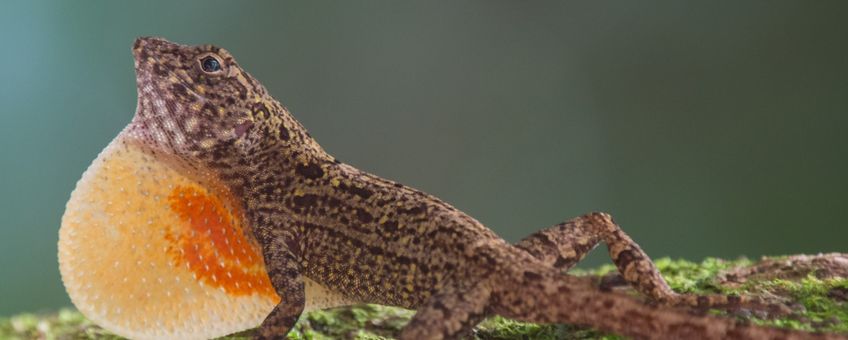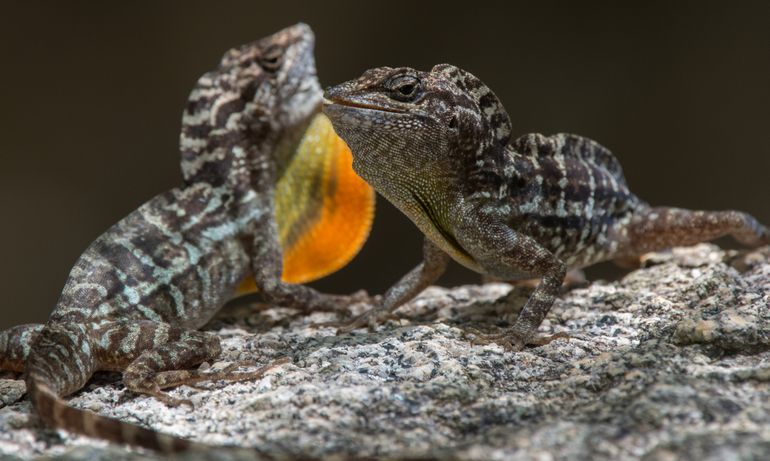
Diurnal reptile is found to be active during full moon
Dutch Caribbean Nature Alliance (DCNA), National Museum of Natural History MadridWith some exceptions, as always in biology, species can be divided in having a diurnal of nocturnal day rhythm. But not all species uphold this clear distinction. Namely, biologists have published rare occasions where diurnal birds, mammals, or even reptiles were observed to be active at night. However, these occurrences are so rare and infrequent that little research has focused on this topic, but perhaps until now.

Model organism
Scientists use model organisms to study numerous biological aspects. These are species that tend to have such characteristics that make them easy to raise, maintain alive, and keep in large numbers to boost statistic power. Some well-known examples are fruit flies, mice, and yeast. For reptilian species, which are coldblooded vertebrates, anole lizards (genus Anolis) are among the most well-known.
Anolis lizards
Highly diverse and heavily studied, the Anolis genus consists of more than 400 species of small lizards that occur in warm regions of the continental Americas and Greater Caribbean region. A well-known feature is their, mostly, colorful dewlap which has a function in male-male and male-female communication. Given the high interest into these species, the scientific community has collected a wealth of (genetic) information on their ecology, physiology and evolution. It is these aspects that make recent observations especially interesting.
New research
During 2019, members of the local NGO WildDominique on the Commonwealth of Dominica gained novel insights into anole ecology. While performing nightly surveys to monitor invasive alien frogs, actively hunting anoles were observed on two occasions during nights adjacent to full-moon nights. The observations concerned another alien species, the Puerto Rican crested anole (Anolis cristatellus) which settled on Dominica roughly two decades ago. Although anoles are occasionally seen active after sunset, such observations have always been facilitated by anthropogenic light sources. The observations on Dominica are of special interest as they present the first instances where it has been observed that moon light can facilitate anoles to perceive their surroundings.
Report your sightings
Due to the model organism status of anoles, scientists can better study this seemingly overlooked part of their biology. Beyond scientists, citizen scientists can aid our understanding about this little-known aspect of anole biology, and we encourage Caribbean residents to venture out during warm summer nights around full moon to identify whether other species of Anolis also exhibit this behavior. To do so, look for an area free of anthropogenic light sources and use your everyday torch to see what the anoles are up to. On each of the Caribbean islands within the Dutch Kingdom occurs one, or multiple, species of Anolis.
You can report any sightings or photos you have of anole lizards or other species on Dutchcaribbean.observation.org. This is a free website and app (iPhone (iObs) & Android (ObsMapp)) which allows not only scientists but also citizens and tourists to report sightings of important plants and animals. These tools are available in over 40 languages and can be used by biologists and citizens and tourists alike. For questions, please contact research@DCNAnature.org.
More information
Text: Matthijs P. van den Burg, Museo Nacional de Ciencias Naturales and Dutch Caribbean Nature Alliance (DCNA)
Photos: Matthijs P. van den Burg (lead photo: Anolis allogus in Cuban rainforest)
